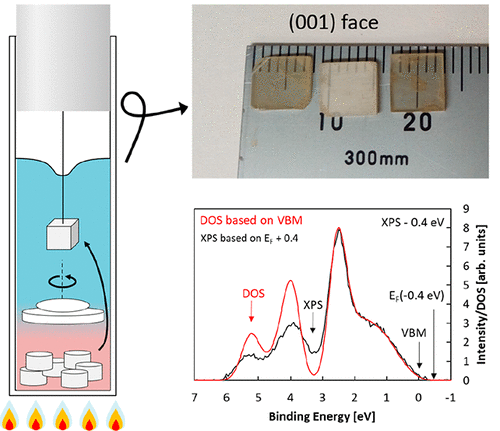当前位置:
X-MOL 学术
›
Cryst. Growth Des.
›
论文详情
Our official English website, www.x-mol.net, welcomes your
feedback! (Note: you will need to create a separate account there.)
Growth of Large Single Crystals of Copper Iodide by a Temperature Difference Method Using Feed Crystal Under Ambient Pressure
Crystal Growth & Design ( IF 3.2 ) Pub Date : 2018-09-27 00:00:00 , DOI: 10.1021/acs.cgd.8b01024 Satoshi Koyasu 1 , Naoto Umezawa 2, 3 , John D. Baniecki 4 , Akira Yamaguchi 1 , Masahiro Miyauchi 1
Crystal Growth & Design ( IF 3.2 ) Pub Date : 2018-09-27 00:00:00 , DOI: 10.1021/acs.cgd.8b01024 Satoshi Koyasu 1 , Naoto Umezawa 2, 3 , John D. Baniecki 4 , Akira Yamaguchi 1 , Masahiro Miyauchi 1
Affiliation

|
A large single crystal of CuI was fabricated by the temperature difference method using NH4I aqueous solution. To explore the efficient crystal growth condition, we calculate the phase diagram of copper iodide components as a function of pH and redox potential by using thermodynamic simulation software, and we also measured the experimental solubility curve of CuI. Consequently, we could fabricate the largest CuI single crystal (8.6 × 9.1 × 14 mm3) to date. Crystal shape was also controllable by the stirring condition in the reactor; i.e., tetrahedron or cubic shape of crystals was formed under stirring or without stirring condition, respectively. Further, the highly pure and transparent CuI crystal was fabricated by the addition of sodium sulfite (Na2SO3) into NH4I aqueous solution. The electronic structure of our high quality CuI single crystal was determined using X-ray photoelectron spectroscopy and ultraviolet photoemission spectroscopy, and the ionization potential of the CuI (001) facet was elucidated to be 5.2 ± 0.2 eV. Even though our CuI crystal was optically transparent, it exhibited low resistivity p-type behavior with high hall mobility (22.1–46.4 cm2 V–1 s–1). The acceptor level of our CuI crystal was also determined by the temperature dependence of the Hall effect property (0.15 ± 0.004 eV), which was consistent with the theoretical calculation on the CuI crystal model with p-type carriers. The present crystal growth method is quite facile and does not require any expensive fabrication equipment. Therefore, our CuI single crystal is expected to be useful as a p-type transparent substrate for the epitaxial growth of various electronic or optical devices, especially for materials with large lattice parameters.
中文翻译:

在常压下利用进料晶体通过温差法生长碘化铜大单晶
使用NH 4 I水溶液,通过温差法制得大的CuI单晶。为了探索有效的晶体生长条件,我们使用热力学模拟软件计算了碘化铜组分的相图随pH和氧化还原电位的变化,并测量了CuI的实验溶解度曲线。因此,我们可以制造迄今为止最大的CuI单晶(8.6×9.1×14 mm 3)。晶体形状也可通过反应器中的搅拌条件来控制。即,在搅拌或不搅拌条件下分别形成四面体或立方晶体。此外,通过添加亚硫酸钠(Na 2 SO3)倒入NH 4 I水溶液中。我们使用X射线光电子能谱和紫外光电子能谱确定了我们高质量CuI单晶的电子结构,并将CuI(001)小面的电离电势确定为5.2±0.2 eV。即使我们的CuI晶体是光学透明的,它仍表现出低电阻率的p型行为和高霍尔迁移率(22.1–46.4 cm 2 V –1 s –1)。我们的CuI晶体的受主能级也由霍尔效应特性的温度依赖性(0.15±0.004 eV)确定,这与对带有p型载流子的CuI晶体模型的理论计算是一致的。本发明的晶体生长方法很容易并且不需要任何昂贵的制造设备。因此,我们的CuI单晶有望作为p型透明衬底用于各种电子或光学器件的外延生长,特别是对于具有大晶格参数的材料。
更新日期:2018-09-27
中文翻译:

在常压下利用进料晶体通过温差法生长碘化铜大单晶
使用NH 4 I水溶液,通过温差法制得大的CuI单晶。为了探索有效的晶体生长条件,我们使用热力学模拟软件计算了碘化铜组分的相图随pH和氧化还原电位的变化,并测量了CuI的实验溶解度曲线。因此,我们可以制造迄今为止最大的CuI单晶(8.6×9.1×14 mm 3)。晶体形状也可通过反应器中的搅拌条件来控制。即,在搅拌或不搅拌条件下分别形成四面体或立方晶体。此外,通过添加亚硫酸钠(Na 2 SO3)倒入NH 4 I水溶液中。我们使用X射线光电子能谱和紫外光电子能谱确定了我们高质量CuI单晶的电子结构,并将CuI(001)小面的电离电势确定为5.2±0.2 eV。即使我们的CuI晶体是光学透明的,它仍表现出低电阻率的p型行为和高霍尔迁移率(22.1–46.4 cm 2 V –1 s –1)。我们的CuI晶体的受主能级也由霍尔效应特性的温度依赖性(0.15±0.004 eV)确定,这与对带有p型载流子的CuI晶体模型的理论计算是一致的。本发明的晶体生长方法很容易并且不需要任何昂贵的制造设备。因此,我们的CuI单晶有望作为p型透明衬底用于各种电子或光学器件的外延生长,特别是对于具有大晶格参数的材料。

















































 京公网安备 11010802027423号
京公网安备 11010802027423号